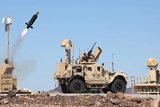How do we detect and defeat enemy drones?
Learn about the portfolio of sensors and effectors for the complete counter-UAS mission at Raytheon, an RTX business.
E-2D Hawkeye on the flight line. (Photo: USN/Mass Communication Specialist 2nd Class Kenneth Abbate)
The USN has ordered analysis tools and performance analysis to support improvements to its E-2D Advanced Hawkeye airborne early warning and control (AEW&C) aircraft.
Work on a contract from the Naval Air Warfare Center Aircraft Division will be performed by Toyon Research Corporation at four US locations for completion by July 2024.
‘Additionally, this order provides two E-2D Delta System Software Configuration (DSSC)-4 mission computer upgrade kits to support analysis of E-2D DSSC-4 in an operational environment, as well as develop system requirements to update the E-2D All-source Track and ID Fuser data fusion engine to accept data from tactical information web services,’ the DoD noted in a 3 May announcement.
This work feeds directly into efforts by the USN and industry to develop a method that would analyse different approaches of combining tracks from multiple disparate data sources, and identify the approach that results in the best overall track accuracy within the processing and time constraints available.
The USN in January 2022 received its final E-2D under the first multi-year procurement contract with Northrop Grumman.
The latest Advanced Hawkeye features the DSSC Build 3, which (according to Northrop Grumman) ‘provides an additional leap in operational effectiveness and technology’ with an aerial refuelling capability and a dwell-based tracker.
Shephard Defence Insight notes that the USN signed a $3.2 billion multi-year contract in 2019 to acquire 24 additional E-2D aircraft, with a production deadline of 2026.
Deliveries under this MYP 2 contract will begin in 2022.

Learn about the portfolio of sensors and effectors for the complete counter-UAS mission at Raytheon, an RTX business.

The US-based tests successfully demonstrated the first live trial of a precision guided missile from a modified TRV-150 drone which destroyed both aerial and ground targets.

India’s stealth fighter ambitions gain fresh momentum as HAL opens the door to private sector involvement in AMCA Mk1A structural assembly, with strategic support growing for next-gen propulsion and sensor technologies.

A key part in the trinational Global Combat Air Programme (GCAP), this is the first crewed supersonic aircraft demonstrator to be built and developed in the UK in more than 40 years.

Kratos’ XQ-58A Valkyrie will be equipped with an Airbus-made mission system to be offered as a ‘European’ collaborative combat aircraft option to the German Air Force.

The munitions variant of the Barrauda-100 autonomous air vehicle is being tested for the US Army’s High-Speed Manoeuvrable Missile (HSMM) testbed programme, with further flight tests expected in 2026.